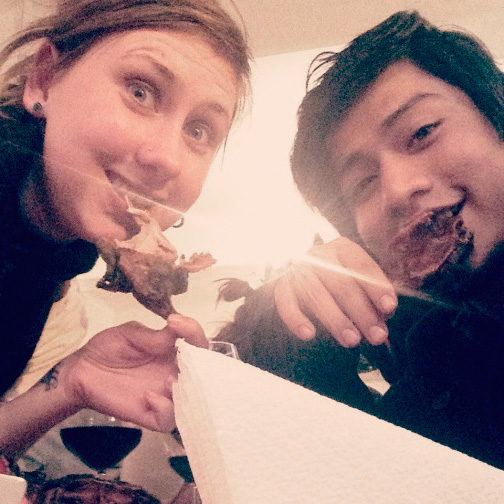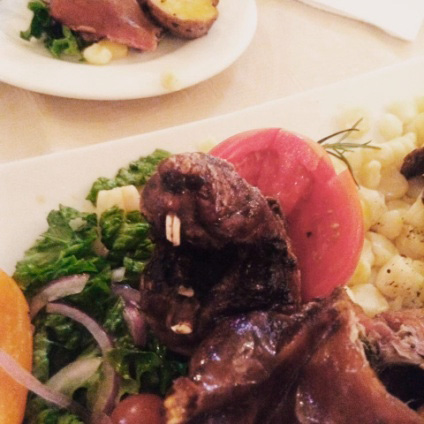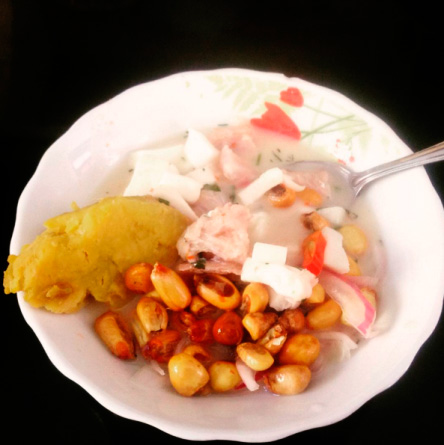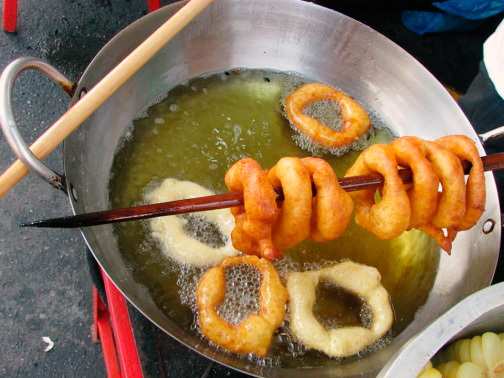When I first arrived in Peru, I must admit I didn´t feel totally comfortable eating the Peruvian cuisine however the more time that I spend here, and the more I try of it the more I seem fall in love.
You may be taken aback at first by 2-3 servings of carbohydrates on one plate, the prospect of eating raw fish, cow´s heart or your beloved pet guinea pig (I know I was) but I promise once you get past that there is a lot to appreciate.
The interesting thing about Peru is that each region has different signature plates and you really need to travel to all parts of Peru to get the full culinary experience.
I will never forget the first time I heard a description of Ceviche from a friend who had visited Peru… as soon as she mentioned the chunks of uncooked fish that the plate consisted of it was a definite no for me and I vowed never to try it. However I have since learnt that the fish in Ceviche is actually cooked, just not in the conventional way you would have thought. It is actually the acidity of the lime juice in the dish that “cooks” the seafood. I have now since tried Ceviche more than a few times and believe it or not it is actually delicious (and surprisingly not bad for a hangover too!). If you´re going to try Ceviche while you are in Peru it would be best to try it somewhere along the coastline, to ensure that the plate is made with the freshest and most delicious seafood.
Another interesting culinary experience I have had whilst in Peru was the first time I ate Cuy (known to the tourists as ´guinea pig´). If you are tossing up whether or not to try this, in my personal opinion I think it´s a must. Not because the Cuy is particularly delicious but because I think it is an important part of the cultural experience here in Peru. Also, when you get back home from your vacation and your friends and family ask you if you were brave enough to try it – you are going to want to say yes. Whilst I opted to be served up my first Cuy whole – complete with claws and a set of teeth still intact, you´ll be pleased to know that there are other options which resemble your beloved child pet a little less.
Peruvians consume an estimated 65 million guinea pigs each year and the locals definitely don´t pay tourist prices for this indulgence. If you order this dish in touristic restaurants you will likely pay a tourist price, however some advice from a local… If you wander out of the main Plaza and discover some of the smaller restaurants in the suburban streets, not only will you get a more authentic Peruvian dish but you will also pay a lot less.
If you are feeling parched, you might want to pick yourself up one of the various forms of Chicha, one of the signature beverages of Peru. Chicha is a fermented or non-fermented beverage usually derived from maize. Chicha includes corn beer known as ´Chicha de jora´ and also non-alcoholic beverages such as Chicha Morada, an unfermented Chicha made from purple maize and boiled with pineapple and spices. Whilst the later is more popular, I highly suggest you seek out a local ‘Chicheria’ to try the alcoholic version ´Chicha de jora´. Whilst these may be a bit harder to find as they are usually local unlicensed businesses they are definitely worth the hunt. Chicherias can generally be identified by a bamboo pole sticking out the open door, adorned with (often red) flags, flowers, ribbons or colored plastic bags.
Delicious Peruvian food is not only limited to the restaurants but you will find an abundance of tasty snacks from food venders in the streets. Some of my personal favorites include Papa Rellenas, Corazón de Vaca and Picarones.
Papa Rellenas, similar to potato croquettes, are stuffed potatoes with a delicious filling of chopped beef and onions, whole olives, hard-boiled eggs, cumin and other spices. Once prepared, the potato dough and filling is deep-fried and is served usually accompanied with a “salsa criolla”, or an aji sauce.
Leaving nothing to the imagination, Corazón de Vaca literally translates to ´Cow Heart´. You can buy this fresh of the grill off venders in the street, served on a stick completed with a potato and a spicy green chili sauce. The first few times I tried this, I couldn’t seem to shake this little nagging voice in my head that said ´You´re eating the heart of an animal´. However, being from the heart this type of meat is naturally quite tender and hence more delicious than other parts. I am happy to say that the more I eat of it, the more that little voice in my head seems to disappear. However if eating a cows heart isn’t your thing, you will be glad to know that these street venders do also offer normal beef kebabs and at a cheaper price too.
For desert you can pick yourself up some Picarones, a deep fried doughnut type sweet made from a dough of squash and sweet potato. The Picarones are served hot covered in a sweet molasses syrup . Make sure you have some napkins handy when eating this as it sure does get sticky.
In Peru, no part of the animal will ever go to waste and in the local butchers markets you will literally find every part of the animal for sale, including the heads and the hooves! Some Peruvians even include frogs as part of their soups and shakes. Whilst I haven´t yet become that adventurous I think it’s safe to say that Peru has opened up my culinary horizons and will continue to do so the longer that I live here.









Recent Comments